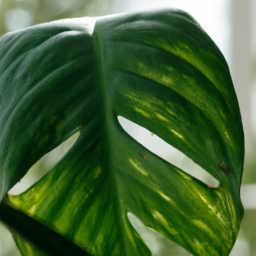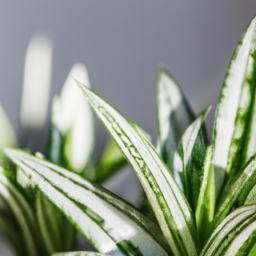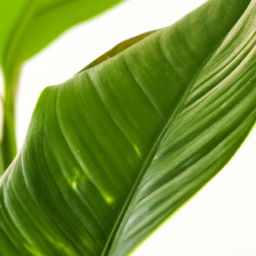
If you love the idea of having indoor plants but suffer from allergies, you may have been hesitant to bring greenery into your home. However, there is a solution – indoor plants without pollen. These plants can add a touch of nature to your living space without triggering your allergies. In this blog post, we will explore a variety of indoor plants that are low in pollen or pollen-free, allowing you to enjoy the benefits of greenery without the sneezing and itching. Let’s dive in and discover the perfect plants for your allergy-free indoor garden.
Benefits of Indoor Plants Without Pollen
Improved Air Quality
Indoor plants are known for their ability to purify the air by absorbing toxins and releasing oxygen. However, for individuals who suffer from allergies, the pollen produced by some plants can exacerbate their symptoms. By choosing indoor plants without pollen, you can enjoy the benefits of cleaner air without the risk of triggering allergies. These plants can help remove pollutants such as formaldehyde, benzene, and trichloroethylene from the air, creating a healthier indoor environment for you and your family.
In addition to improving air quality, indoor plants without pollen can also help regulate humidity levels in your home. Plants release water vapor through a process known as transpiration, which can help maintain optimal humidity levels in indoor spaces. This can be especially beneficial during the winter months when indoor air tends to be dry due to heating systems. By incorporating plants that do not produce pollen into your indoor space, you can create a more comfortable and healthy environment for yourself and your loved ones.
Furthermore, indoor plants without pollen can have a positive impact on your mental well-being. Studies have shown that being surrounded by plants can reduce stress, anxiety, and depression. The presence of greenery indoors can help create a sense of calm and tranquility, promoting relaxation and improving overall mood. By choosing plants that do not produce pollen, you can reap the mental health benefits of indoor gardening without worrying about allergic reactions.
Low Maintenance
One of the advantages of indoor plants without pollen is that they are often low maintenance, making them ideal for individuals with busy lifestyles or limited gardening experience. These plants typically require minimal watering, sunlight, and care, making them easy to incorporate into your indoor space. Some popular low-maintenance indoor plants that do not produce pollen include snake plants, spider plants, and peace lilies.
In addition to being easy to care for, indoor plants without pollen can also thrive in a variety of indoor environments. Whether you have a sunny window sill or a dimly lit corner, there are non-pollinating plants that can thrive in your space. By choosing plants that are well-suited to your specific indoor conditions, you can enjoy the benefits of greenery without the hassle of constant maintenance.
Furthermore, low-maintenance indoor plants without pollen can help improve indoor air quality with minimal effort on your part. These plants can continue to purify the air and release oxygen without requiring extensive care, making them a convenient and effective way to enhance your indoor environment. By selecting plants that are easy to care for and do not produce pollen, you can enjoy the benefits of indoor gardening without the stress of high maintenance requirements.
Enhanced Aesthetics
Indoor plants without pollen can also enhance the aesthetics of your indoor space, adding a touch of natural beauty and tranquility to your home or office. Whether you prefer lush green foliage or colorful blooms, there are non-pollinating plants that can complement your interior decor and create a welcoming atmosphere. From hanging plants to tabletop varieties, there are countless options to choose from when it comes to incorporating plants into your indoor space.
In addition to adding visual appeal, indoor plants without pollen can also help improve the acoustics of your indoor environment. Plants have been shown to absorb sound waves, reducing noise levels and creating a more peaceful atmosphere. By strategically placing non-pollinating plants throughout your indoor space, you can create a more serene and harmonious environment that promotes relaxation and focus.
Furthermore, indoor plants without pollen can serve as natural focal points in your interior design, drawing the eye and adding interest to your space. Whether you opt for a statement plant in a decorative pot or a collection of smaller plants grouped together, incorporating greenery into your indoor decor can help create a cohesive and inviting atmosphere. By selecting plants that do not produce pollen, you can enjoy the visual benefits of indoor gardening without the worry of allergic reactions.

Best Types of Indoor Plants for Allergy Sufferers
Introduction
Are you an allergy sufferer looking to bring some greenery into your home without the worry of pollen? Look no further! There are plenty of indoor plants that are perfect for those with allergies. In this guide, we will explore the best types of indoor plants that are low in pollen and safe for allergy sufferers to enjoy.
Low-Pollen Indoor Plants
When choosing indoor plants for allergy sufferers, it’s important to select varieties that are known for producing minimal pollen. One great option is the Boston Fern, which is a popular choice for its lush green foliage and low pollen production. Another excellent choice is the Peace Lily, which not only adds a touch of elegance to any space but also has low pollen levels. The Spider Plant is another good option, as it is easy to care for and has minimal pollen.
It’s also worth considering plants that are known for their air-purifying properties, as these can help to improve indoor air quality and reduce allergy symptoms. The Snake Plant, for example, is a great choice for allergy sufferers as it is low in pollen and can help to remove toxins from the air. The Areca Palm is another good option, as it is known for its ability to remove harmful chemicals from the air and has low pollen levels.
When selecting indoor plants for allergy sufferers, it’s important to choose varieties that are easy to care for and thrive in indoor environments. Plants like the Rubber Plant, Dracaena, and ZZ Plant are all excellent choices for those with allergies, as they require minimal maintenance and have low pollen levels. By choosing plants that are low in pollen and easy to care for, you can enjoy the benefits of indoor greenery without aggravating your allergies.
Tips for Allergy Sufferers
In addition to selecting the right indoor plants, there are a few tips that allergy sufferers can follow to help reduce their symptoms. One important tip is to regularly dust and clean your plants, as pollen can accumulate on leaves and contribute to allergy symptoms. It’s also a good idea to avoid overwatering your plants, as this can create a damp environment that is conducive to mold growth, which can trigger allergies.
Another tip for allergy sufferers is to keep indoor plants in well-ventilated areas, as this can help to prevent pollen from building up in the air. Opening windows and using a fan can help to circulate air and reduce pollen levels indoors. Additionally, it’s a good idea to avoid placing plants in bedrooms, as pollen can disrupt sleep and worsen allergy symptoms.
By following these tips and selecting the right indoor plants, allergy sufferers can enjoy the benefits of greenery in their homes without the worry of pollen. With the right plants and proper care, you can create a beautiful and allergy-friendly indoor garden that will brighten up your space and improve your overall well-being.

Tips for Maintaining Indoor Plants Without Pollen
Choosing the Right Indoor Plants
When it comes to maintaining indoor plants without pollen, the first step is to choose the right plants. There are many indoor plants that are considered hypoallergenic, meaning they produce little to no pollen. Some popular options include spider plants, peace lilies, and snake plants. These plants are not only beautiful additions to your home, but they are also safe for individuals with pollen allergies. When selecting indoor plants, be sure to read the labels carefully and choose plants that are known for their low pollen production.
In addition to choosing hypoallergenic plants, it’s important to consider the overall health of the plant. Make sure to inspect the leaves and stems for any signs of pests or disease. Healthy plants are less likely to produce pollen, so it’s important to keep your plants well-maintained. Regularly watering, fertilizing, and pruning your indoor plants will help keep them healthy and pollen-free.
Another factor to consider when choosing indoor plants is their size and placement in your home. Larger plants tend to produce more pollen than smaller plants, so if you have limited space, opt for smaller varieties. Additionally, placing your indoor plants in well-ventilated areas can help reduce the spread of pollen. Consider placing plants near windows or doors that can be opened to allow for fresh air circulation.
Proper Care and Maintenance
Once you have selected the right indoor plants, proper care and maintenance are essential for keeping them pollen-free. Regular watering is crucial for the health of your plants, but be careful not to overwater. Overwatering can lead to mold growth, which can trigger allergies in sensitive individuals. Make sure to water your plants only when the soil feels dry to the touch, and avoid letting water sit in the saucer beneath the pot.
In addition to watering, fertilizing your indoor plants is important for their overall health. However, be cautious when choosing fertilizers, as some can contain allergens that may trigger reactions in individuals with pollen allergies. Opt for organic or hypoallergenic fertilizers to minimize the risk of pollen exposure. It’s also a good idea to periodically clean the leaves of your plants to remove any dust or pollen that may have accumulated.
Proper lighting is another key factor in maintaining indoor plants without pollen. Most indoor plants thrive in bright, indirect light, so be sure to place your plants in locations where they can receive adequate light. Avoid placing plants in direct sunlight, as this can cause them to produce more pollen. If you notice your plants are not getting enough light, consider supplementing with artificial grow lights to keep them healthy and pollen-free.
Preventing Pollen Cross-Contamination
Even with the best care and maintenance, pollen cross-contamination can still occur in indoor plants. To prevent this, it’s important to keep your plants isolated from outdoor plants that may produce pollen. If you have outdoor plants that are known allergens, such as ragweed or grasses, avoid bringing them indoors or keep them in a separate area from your hypoallergenic indoor plants.
Regularly inspect your indoor plants for any signs of pests or disease, as these can also contribute to pollen production. If you notice any issues, quarantine the affected plant until it can be treated. It’s also a good idea to periodically rotate your plants to ensure they are all receiving adequate light and airflow. This can help prevent the buildup of pollen and other allergens in your home.
In conclusion, maintaining indoor plants without pollen requires careful selection, proper care, and preventive measures. By choosing hypoallergenic plants, providing them with the right conditions, and staying vigilant for signs of pollen production, you can enjoy the beauty of indoor plants without the worry of triggering allergies. Remember to regularly clean your plants, keep them well-maintained, and prevent cross-contamination to create a healthy and pollen-free environment in your home.
Key Takeaways of this article
If you’re someone who loves the idea of having indoor plants but suffers from allergies, you might be hesitant to bring greenery into your home. However, there are plenty of indoor plants that don’t produce pollen, making them a great option for allergy sufferers. These plants can still help improve air quality, boost your mood, and add a touch of nature to your space without triggering any sneezing or congestion.
Some popular indoor plants that don’t produce pollen include spider plants, snake plants, and peace lilies. These plants are not only beautiful and easy to care for, but they also have the added benefit of being allergy-friendly. So if you’ve been hesitant to bring plants into your home due to allergies, consider adding some pollen-free options to your indoor garden and enjoy the benefits of greenery without the sneezing.
Check Out These FAQs:
Q1. Are there indoor plants that do not produce pollen?
A1. Yes, there are several indoor plants that are considered hypoallergenic because they produce little to no pollen. Some popular options include snake plants, spider plants, and peace lilies.
Q2. How can I ensure that the indoor plants I choose do not release pollen?
A2. To ensure that the indoor plants you choose do not release pollen, it is best to select plants that are known for their low pollen production. You can also opt for plants with large, showy flowers as they are less likely to release pollen.
Q3. Are there any benefits to having indoor plants without pollen?
A3. Yes, there are several benefits to having indoor plants without pollen. These plants are ideal for individuals with allergies or asthma as they are less likely to trigger symptoms. Additionally, low-pollen plants can help improve indoor air quality and create a healthier living environment.
Q4. Can indoor plants without pollen still help improve indoor air quality?
A4. Yes, indoor plants without pollen can still help improve indoor air quality. These plants are known for their ability to remove toxins from the air through a process called phytoremediation. By choosing low-pollen plants, you can still enjoy the air-purifying benefits of indoor greenery.
Q5. How can I care for indoor plants without pollen to ensure they thrive?
A5. To care for indoor plants without pollen, it is important to provide them with the proper amount of sunlight, water, and nutrients. Be sure to research the specific care requirements of each plant you choose to ensure they thrive in your indoor environment.

James Wong is a renowned ethnobotanist, plant scientist, and local television presenter. With a passion for demystifying plant science, he is known for translating complex botanical concepts into practical advice for everyday plant enthusiasts. James’s expertise spans from traditional gardening to cutting-edge plant technologies, making his insights accessible and informative.


